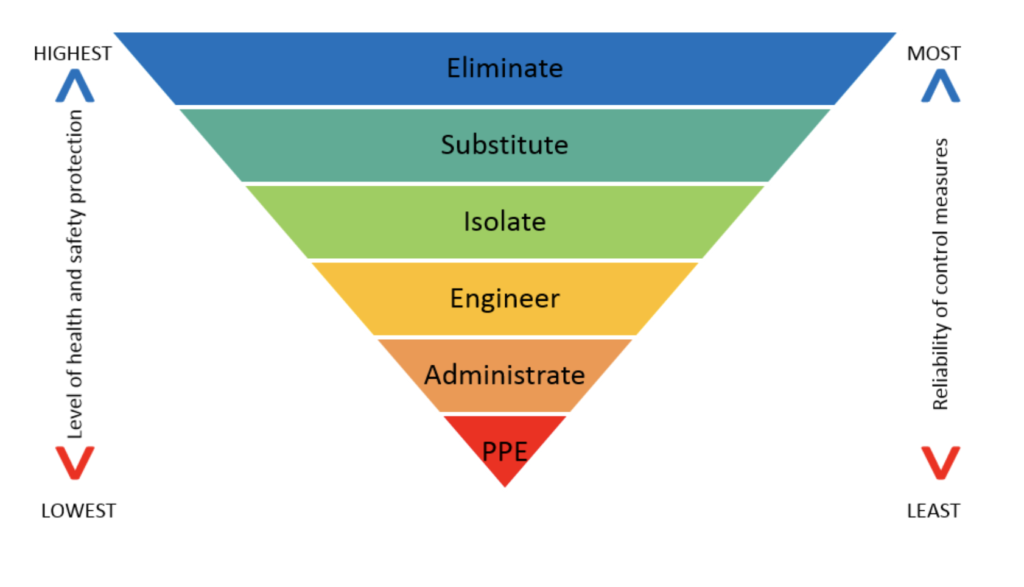Supporting Workers – Paid Pandemic and Vaccination Leave
Thanks for entering your email, you can read your factsheet here.
Across all industries and workplaces, over two-million workers in unions across Australia continue to negotiate higher pay to ensure all members get a fair wage for a fair day’s work. Join your union today and make it happen.Coronavirus (COVID-19): Supporting workers
COVID–19 is a health and safety risk. Employers and other duty holders (such as property managers/owners) have obligations to ensure the health and safety of workers and others. They must identify risks relating to COVID-19 have a plan on what will be done to protect and support workers, and health and safety representatives (HSRs) must be consulted on this plan.
As with any other risk, employers/PCBUs must consider how to implement the most reliable ways to prevent harm. This should involve the application of the hierarchy of controls (refer to the diagram below). The hierarchy of controls requires priority to be placed on the elimination of hazards, or isolation of people from exposure to harm where possible. Lower order administrative controls which focus on individual worker behaviours or the application of PPE should only be applied where higher order controls are not possible or effective.
Hierarchy of controls

Applying the hierarchy of controls to COVID-19 may require multiple measures to be implemented in a workplace. The best risk control measure for preventing exposure to COVID-19 is physical distancing, which may include working from home where practicable, which, together with other measures, such as providing paid leave to all workers who have reason to believe they have COVID-19.
Stay home whilst sick
Coronavirus is a highly contagious virus that spreads from people who have mild or even no symptoms of the illness. It is an important work health and safety, as well as public health measure to encourage workers who have been exposed to known cases of coronavirus or are sick to stay home and isolate. The development of rapid testing and home testing kits offers effective ways to identify positive cases, including those that do not have symptoms, quickly. These workers should be supported, including financially to isolate.
For many workers who have no or limited access to paid sick leave, this will cause significant financial hardship which is likely to act as a disincentive to stay home. The absence of paid leave is a health and safety risk that must be managed and controlled. This represents a significant risk to these workers, their workmates and the broader community as we face the challenge of opening up and guarding against a further surge in COVID-19 cases.
What is paid pandemic leave?
Paid pandemic leave, sometimes referred to as special paid leave or miscellaneous leave, is paid leave available to all workers, whether they be permanent, casual or labour hire who suspect they may have coronavirus (due to experiencing symptoms or close contact with a confirmed case) to isolate, get tested and rehabilitate if positive.
Whilst many Australian businesses and employers have implemented paid pandemic leave there are millions of workers, including over 3 million casual and insecure workers who have no access to any form of paid sick leave. This represents a significant risk to these workers, their workmates and the broader community as we face the challenge of guarding against the second wave of infection.
Australian unions have been campaigning for the Federal Government to introduce an entitlement for workers to be paid for all lost hours and income where they are required to isolate and quarantine.
Unions have won a range of payments that workers can access if they do not have access to leave arrangements. The details of these can be found at Services Australia
What is paid vaccination leave?
Getting access to vaccination is one of the real barriers for workers. To facilitate this employers need to provide paid leave to get the vaccination and up to two days paid leave after the vaccination for those people who have a reaction to the vaccine. Reactions such as fatigue, sore muscles prevent up to one in four people going about normal activities. If that happens access to paid vaccination leave will make it easier for workers to become vaccinated and not lose pay. These reactions are short-lived and workers will be able to return to normal work duties.
What can workers do?
Workers who do not have paid pandemic leave should work with their workmates, health and safety representatives and their employer to understand how the absence of paid pandemic leave is likely to increase the risk of exposure in their workplace.
Given the significant number of casual and insecure workers that have no paid sick leave workers should join the union campaign to encourage the Federal Government to change the law to provide paid leave to these workers to protect the community and ensure that Australia does not experience repeated waves of infections like has been seen in other countries.
Enter your email to access our expert workplace information
Almost two million union members have contributed to us providing this free workplace factsheet. Because you’ve read a few of our factsheets, we’re asking for your email address to keep reading. This is so we can keep you updated with the latest news and workplace advice.
Don’t worry: our factsheets will always remain free, thanks to the solidarity of the union movement.


